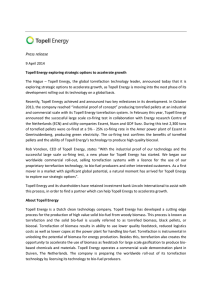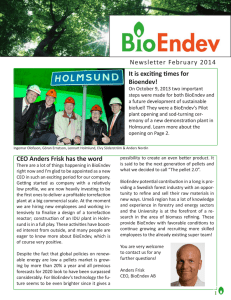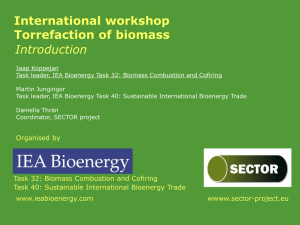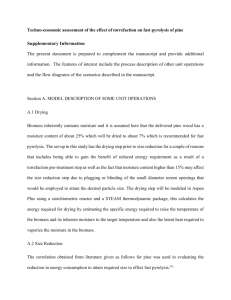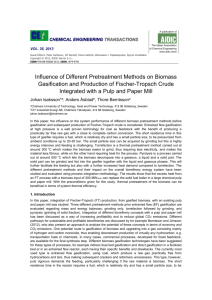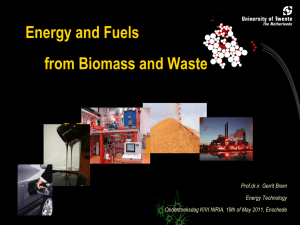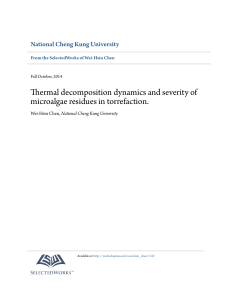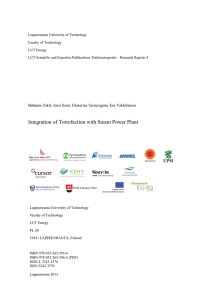Biomass Torrefaction – A Promising P t t
advertisement
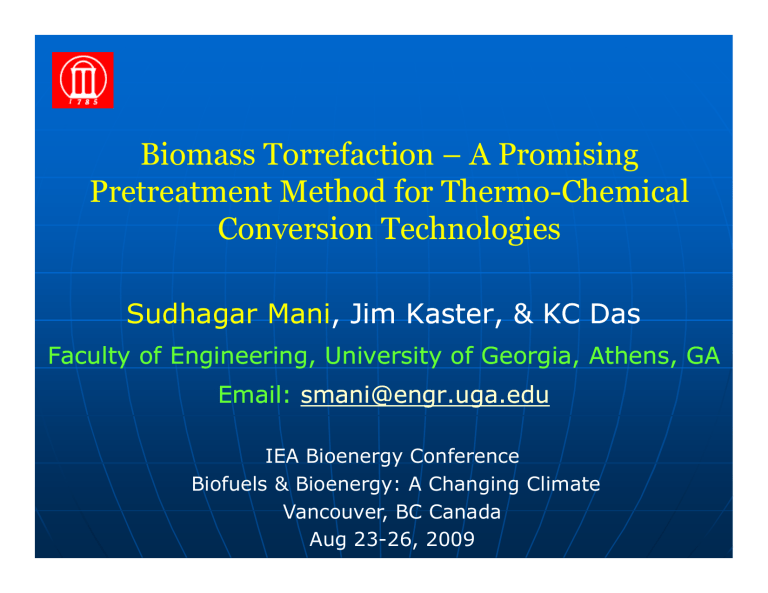
Biomass Torrefaction – A Promising P t t Pretreatment tM Method th d ffor Th Thermo-Chemical Ch i l Conversion Technologies Sudhagar Mani,, Jim Kaster, Kaster, & KC Das Faculty of Engineering, University of Georgia, Athens, GA Email: smani@engr.uga.edu IEA Bioenergy Conference Biofuels & Bioenergy: A Changing Climate Vancouver, BC Canada Aug 23-26, 2009 Introduction Issues with biomass feedstock • Wide range of moisture content (60 (60--15% wb) wb) • Low bulk density (4 – 8 lbs/ft3) • Low energy density (4,500 (4,500--7,500 Btu/lb) • Uneven particle sizes (no flow) • Difficult to handle, handle store and transport • High transport and storage cost • Self heating and emission of off gases during storage Introduction Issues with thermothermo-chemical conversion technologies • Combustion: Difficult to coco-fire with coal Low energy density High energy demand for grinding biomass • Gasification Tar formation Low C/H / ratio for liquid q fuel p production • Pyrolysis Pyrolysis:: Bio--oil instability & coke formation Bio • Densification: Low energy density & self heating Biomass Pyrolysis to Liquid Fuels Pyrolysis Unit Bio-oil Critical Problems • Long Long--term storage and stability of biomass • High energy input for grinding to defined particle size • Formation of high molecular weight compounds • Bio Bio--oil is unstable Vi Viscosity it iincreases with ith ti time and d temperature t t Low pH, corrosive • Catalytic y upgrading pg g difficult High oxygen content Catalytic deactivation due to coke formation What is Torrefaction? Solid-state thermal hydrolysis of biomass in an inert atmosphere (e.g.,N2) T Temperature t range – 180 to t 300oC Hemicellulose is hydrolyzed via release of acetic acid and subsequent hydrolysis reaction Moisture reduction, oxygen content reduced Some extractives volatilized, but 7070-80% solids recovered Most familiar example – roasting coffee Green chip Torrefied chip Torrefaction History 1930’s – heat treatment of wood for high g durability, structural stability & fungal resistance (wood roasting), provides aesthetic value 1939 – US Patent (Bergstrom (Be gst om et al) on thermal the mal heating of wood >220oC 1976 – Pyrochar y process p for solid biomass into fuels 1980’s – heat treatment of wood logs (180 (180-220oC), retifaction/torrefaction process (Yvan, (Yvan 1985 1985, Bourgeois et al, al 1988), 1988) Torrefaction process development & reactor design (four patents) 2000 - Significant research & development on biomass torrefaction process Mass & Energy gy Balance Condensable: Non-condensable: H2, CO, CO2, CH4, Toluene, benzene Volatile off gases 0.3 m Biomass 1m 1E Water Organic acids, alcohols Furans, ketones Terpenes, phenols l d Waxes, tannins, lipids ~0.2 E Torrefaction Process ~0.1 E External heat supply T Temp: 180 180-280 280oC Heating rate: <50oC/min Residence time: > mins 0.7 m 0.9 E Torrefied biomass Research Objectives Bi Biomass T Torrefaction f ti kinetics ki ti • Does it improve biomass storability and transportability? t t bilit ? • Does it improve biomass grindability and reduce energy input? i t? • Effect of torrefaction on, bi bio-oil il stability t bilit Eliminate or reduce coke forming precursors and improve catalytic upgrading of bio-oil to fuels Syngas quality and tar concentration during g gasification Pellet quality Combustion behavior Mass loss with time for a range of torrefaction conditions – TG TG-MS MS 100 % mass s remain ning 90 80 70 200 60 215 230 50 245 40 260 30 275 20 pyr. @ 700 10 0 0 2000 4000 time / s 6000 8000 Proposed Torrefaction Kinetics M d l Model Hemicellulose (A) k1 Depolymerised Intermediate (B) k2 Solid products (C) kv2 kv1 Volatile products Model equations: For components a, b and c: a’(t) = -(k1+kv1)*a(t), a(0) = 1 (normalized vs. starting mass) b’(t) = k1*a(t)k1*a(t)-(k2+kv2)*b(t) b(0) = 0 c’(t) = k2*b(t) c(0) = 0 Torrefaction Experiment Condensed liquids Torrefaction Reactor Forest Residue chips Non-condensable gases Experiment 1.3.2 - Torrefaction - Pine Chips 30 minutes - 280oC - 30% Moisture 300 250 Tem mperature (oC) 200 150 100 50 0 0 15 30 45 60 75 Time (minutes) 90 105 120 Torrefied biomass Torrefied Auger Reactor - UGA •Continuous Reactor •Capacity Capacity – 5 to 10 kg/h •Capability to collect condensable • Non-condensables gases can be recalculated in the auger Rotary drum reactor – UGA (indirect heating) Capacity = 400 lbs/run Results – Torrefied biomass yield Pine Chips30 Minute run Torrefied b biomass yield d (%) 100% 80% 60% 40% 10%M.C. 20% 30% C 30%M.C. 50%M.C. 0% 220 250 Temperature 280 Torrefaction of Pine Chips p Torrefaction Process Torrefaction Results GC/MS of Non-condensables (gas phase) • Acetaldehyde, α-pinene pinene,, βpinene,, camphene, phellandrene observed at low pinene temperatures (220C) • Acetaldehyde evolution increased with time • Pinenes decreased with holding time • As temperature p increased,, acetic acid,, methylester y and furans appeared (220 to 250C and above) Furan, 2 2--methylfuran, 250C 2 2,3 2,33-dihydrofuran and 2,52 5-dimethylfuran, 2,5 dimethylfuran 280C Results – Non Non--condensable at 280oC Non-Condensables vs. Time; Torrefaction at 280oC 9 Methane 8 Carbon dioxide Methyl acetylene Am mount (mole % %) 7 Propylene 6 n-Butane 5 Ethylene Ethane 4 3 2 1 0 0 10 20 30 Time (min) 40 50 60 Results – Condensable at 280oC Condensables vs. Time; Torrefaction - 280oC 35000000 α-pinene α pinene camphene Re elative Abunda ance 30000000 β-pinene 25000000 β phellandrene β-phellandrene 20000000 15000000 10000000 50000000 0 0 10 20 30 Time (min) 40 50 60 Results – Compositional changes Forestt residue F id chips Cellulose C ll l (% wt) Hemi-cellulose H i ll l (% wt) Lignin Li i (% wt) Heating H ti value l (Btu/lb) Non-torrefied (10% m.c.) mc) 43.1 18.4 20.9 7,774 Torrefied at 220oC 40.7 12.0 25.1 8,474 Torrefied at 250oC 37.3 5.0 31.8 9,376 , Torrefied at 280oC 20.6 2.9 47.3 10,167 Forestt residue F id chips C H O N S A h (% wt) Ash t) Non-torrefied (10% m.c.) mc) 45.3 5.9 48.5 0.3 0.1 0.6 Torrefied at 220oC 49.4 5.5 44.1 0.3 0.0 1.1 Torrefied at 250oC 50.5 5.4 41.8 0.4 0.0 1.2 Torrefied at 280oC 56.4 5.4 36.1 0.9 0.1 1.4 Results – Compositional changes Forestt residue F id chips Moisture M i t (%) Volatile V l til C (% wt) Fixed Fi dC (% wt) A h (%) Ash Non-torrefied (10% m.c.) mc) 10 75.3 16.3 0.4 Torrefied at 220oC 3.2 76.8 19.1 1.1 Torrefied at 250oC 2.3 74.9 20.6 1.2 Torrefied at 280oC 2.1 70.8 25.6 1.4 Change in bulk density during T Torrefaction f ti Bulk dens sity, kg/ /m3 200 179.51 175 160.43 152.13 150 125 220 250 280 Torrefaction temperature oC Forest biomass chips – 18% change Improved Pelleting Process Raw material Drying process Grinding Torrefaction Torrefaction Drying Pelletization Pelletization P ll ti ti High quality Products Pellets Effect of Torrefaction on Pellet Density 1200 Pelle et Densitty, kg/m m3 1100 220 1000 900 Control 800 220 250 700 280 280 600 0 2000 4000 Applied Forces, N 6000 8000 Pelle et Produ uction c cost, $/ /t Torrefaction-- Pellet Production Cost Torrefaction 50 Packing cost $40 Land use & building 40 $27 $24 $30 30 Miscellaneous equipment Screening 20 0.00 Pellet cooler 10 0 Personnel cost 0.00 0 6.45 Pellet mill Hammer mill Torrefaction Drying operation 24 Torrefaction - Pyrolysis TG/MS Analysis of Torrefied Biomass TGA/MS ((Mettler Mettler Toledo) Performed P f d under d pyrolytic l ti conditions diti – N2 or Ar A carrier gas 10mg sample, 50 ml/min, 3030-900 900°°C at 10° 10°C/min Monitored Off Gas in Selective Ion Mode (SIM) • Non-condensables, CO-28, CO2-44, H2-2, H2O-18 • Potential tar compounds, Benzene – 78 Guaiacol – 124 Naphthalene – 128 Phenol – 94 • Potential hemicellulose breakdown products Acetaldehyde – 29 Acetic acid – 60 Acetol – 45 Effect of Torrefaction on Pyrolysis Kinetics (TGA Analysis) 12 1 10 08 0.8 10 08 0.8 0.6 6 0.4 4 02 0.2 2 0 0 0.6 6 0.4 4 0.2 2 0 0 1000 0 X, fractional biomass conversion Higher g e temperature e pe a u e torrefaction o e ac o (> 300° 300°C) appears to reduce biomass thermal decomposition and alter pyrolysis kinetics More research needed to confirm effect 500 0 1000 Temperature, C Torrifie d Pine Pe lle ts at 300C Mass (mg) 500 Tem perature, C 8 12 1 10 08 0.8 8 0.6 6 0.4 4 02 0.2 2 0 0 500 Te m pe rature , C 0 1000 X, mass 8 Mass (mg) 1 X, mass Mass, mg 12 X, mass Torrified Pine Pellets at 250C Pine Pellet Pyrolysis Torrefaction-Pyrolysis-Solids Properties Oxygen content reduced Fixed carbon increased Material Characteristic PP BM PP T250 PP T300 PP T350 PP P500 C H N S O 52.6 5.7 0.2 0.0 38.9 53.9 5.3 0.1 0.1 37.6 73.2 4.7 0.2 0.1 19.6 78.0 3.7 0.2 0.1 15.0 82.5 2.6 0.2 0.0 4.4 Moisture Volatiles Ash Fixed Carbon 77.2 2 79.8 0.5 19.7 00.0 0 71.2 3.0 25.8 11.00 42.4 2.2 55.4 22.00 32.2 2.9 64.9 33.22 28.1 2.8 69.1 HHV (MJ/kg) 20.6 20.9 28.8 29.7 31.0 PP, pine pellets; BM, biomass; T, torrefaction, P, pyrolysis Parameter Ultimate analysis (wt % dry) C H N S Oe HHV (MJ/kg, wet basis) H2 O (wt %) (wt. pH aP: Pa Bio-Oil Characteristics PUb TPc TPUd 69.66 69 7.65 0.74 0.05 22.0 29.1 73.11 73 8.1 0.4 0.0 18.4 30.9 71.33 71 7.97 0.19 0.01 20.5 28.6 73.99 73 7.93 0.17 0.02 18.0 30.7 2.4 4.0 9.3 6.7 3.1 3.2 3.7 3.5 Pyrolysis (catalytic upgrading feedstock, no torrefaction) bPU: Pyrolysis + catalytic Upgrading (no torrefaction) cTP: Torrefaction + Pyrolysis (catalytic upgrading feedstock) dTPU: Torrefaction + Pyrolysis + catalytic Upgrading Torrefaction - Combustion Comparison of combustion of torrefied biomass, untreated biomass and coal 1.2 remain ning frac ction 1 t225 0.8 t235 t250 0.6 t260 t275 0.4 t285 t300 raw pine 0.2 coal 0 0 1000 2000 Time 3000 4000 Conclusions Condensable compounds are mainly released from extractives in the biomass as α, β-pinene, camphene etc. t These Th compounds d can be b redirected di t d to t supply l heat energy during torrefaction During D i torrefaction, t f ti hemi-cellulose h i ll l iis almost l t removed d and results in higher energy density product with a heating value of 10,000 10 000 Btu/lb. Btu/lb Torrefaction temperature plays a major role in defining the energy density y of biomass and can be optimized p for any y specific applications. Torrefaction followed by y pelleting p g costs about $ $30/t of pellets. Torrefaction process alone costs about $6.5/t. Conclusions Biomass torrefaction process can produce high energy density and consistent feedstock for thermal conversion technologies (gasification, co co--firing & pyrolysis) pyrolysis) Pelleting of Torrefaction of biomass may be difficult due to hydrophobic nature of the material and require additional binders to increase the bulk density Future research at UGA is focused on optimizing the best reactor configuration g for a torrefaction p process and promote its application to co-firing, gasification and pyrolysis processes Acknowledgement Financial support from • University of Georgia Research Foundation • State of Georgia – Traditional Industries Program • Georgia Power – Southern Company Thank you Densification Direct combustion Gasification Biocoal Co-firing with coal Biomass Torrefaction Technology
